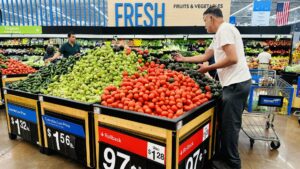The Rising Trend of "Buy Now, Pay Later" for Groceries: What It Means for Your Financial Future
In the ever-evolving landscape of personal finance, a notable trend is capturing attention: the increasing use of Buy Now, Pay Later (BNPL) services, especially for everyday essentials like groceries. As economic pressures mount, many Americans are looking for ways to manage their budgets. Insights from recent data reveal that the appeal of BNPL goes beyond convenience; it also raises questions about financial stability and consumer behavior.
A Shift in Spending Habits
According to recent data from Lending Tree, nearly 50% of American consumers have turned to BNPL services. Alarmingly, around 25% of these users are now financing their grocery bills through these loans—up from just 14% in 2024. This suggests a broader shift in spending habits driven by ongoing inflation and rising interest rates.
The Cost of Convenience
While BNPL loans offer a seemingly attractive way to split larger purchases into manageable installments, consumers should be cautious. Failing to keep up with payments can lead to significant late fees, not to mention the mental burden of juggling multiple loans. The Lending Tree survey indicates that approximately 41% of users paid a BNPL bill late in the past year, a trend that could signal deeper financial issues for many.
Why Are Consumers Resorting to BNPL?
In today’s economic climate, rising prices and uncertain job stability are driving consumers to explore alternatives for financing. As Matt Schulz, chief consumer finance analyst at Lending Tree, notes, “A lot of people are struggling and looking for ways to extend their budget.” The current financial landscape poses unique challenges, from tariffs to fluctuating interest rates, pushing consumers towards BNPL options.
The Double-Edged Sword of BNPL
While the temporary relief BNPL offers can be valuable, it’s important to tread carefully. The allure of interest-free payments may mask potential pitfalls. For instance, 60% of BNPL users reported having multiple loans at once, with nearly a quarter juggling three or more. This can quickly escalate into a complex web of financial obligations.
Extreme Investor Network advises users to approach these services mindfully. Here are some strategies to make the most of BNPL options while mitigating risks:
-
Create a Budget: Before turning to BNPL, assess your monthly expenses and savings. Knowing exactly what you can afford can prevent you from overextending.
-
Limit BNPL Usage: If possible, restrict the number of BNPL loans you take out simultaneously. Focus on essential purchases rather than discretionary items.
-
Understand Terms and Conditions: Make sure to read the fine print. Knowing when payments are due and the penalties for late payments can save you from financial headaches.
- Avoid Impulse Purchases: Just because you can finance a purchase doesn’t mean you should. Take time to consider whether a purchase is necessary.
The Broader Economic Context
What does the rise of BNPL services tell us about the state of the economy? Recently, household names like Walmart and Delta Airlines have reported shifts in consumer spending. They note that demand is weakening, with higher-than-expected sales forecasts becoming increasingly elusive.
This behavior raises questions not just about individual consumer choices but also about the collective financial health of the nation. As more consumers lean on BNPL, it underscores the reality of financial strain among everyday Americans.
Final Thoughts: A Cautionary Note
The growing popularity of BNPL for groceries highlights a critical junction in the way consumers manage their finances. While it can offer short-term relief, long-term reliance on these services may lead to complications and debt. Staying informed and developing a sound financial strategy is crucial.
At Extreme Investor Network, we empower you to make informed decisions about your financial future. Whether you’re considering BNPL or seeking other strategies for financial wellness, our resources can help you navigate today’s economic challenges. You don’t have to face these decisions alone—explore our insights and transform your financial journey today!

